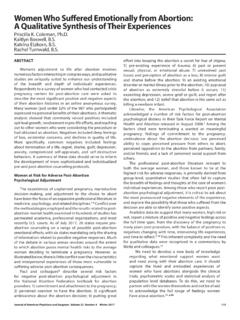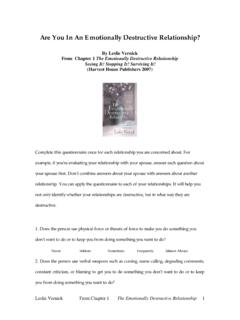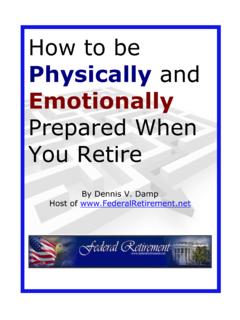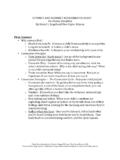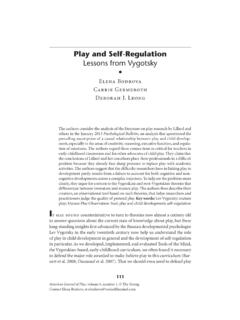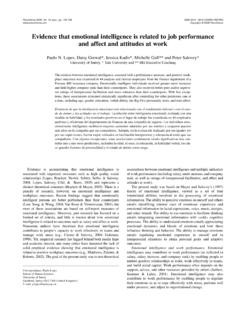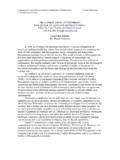Transcription of P.G. 216-05 Mentally Ill Or Emotionally Disturbed …
1 216-05 Mentally Ill Or Emotionally Disturbed PersonsDate Effective: 08/01/13 PURPOSETo safeguard a Mentally ill or Emotionally Disturbed person who does notvoluntarily seek medical primary duty of all members of the service is to preserve human life. Thesafety of ALL persons involved is paramount in cases involving emotionallydisturbed persons . If such person is dangerous to himself or others, necessaryforce may be used to prevent serious physical injury or death. Physical forcewill be used ONLY to the extent necessary to restrain the subject untildelivered to a hospital or detention facility. Deadly physical force will beused ONLY as a last resort to protect the life of the uniformed member of theservice assigned or any other person present.
2 If the Emotionally disturbedperson is armed or violent, no attempt will be made to take the EDP intocustody without the specific direction of a supervisor unless there is animmediate threat of physical harm to the EDP or others are present. If an EDPis not immediately dangerous, the person should be contained until assistancearrives. If the EDP is unarmed, not violent and willing to leave voluntarily,a uniformed member of the service may take such person into custody. Whenthere is time to negotiate, all the time necessary to ensure the safety of allindividuals will be Disturbed PERSON (EDP) - A person who appears to be Mentally illor temporarily deranged and is conducting himself in a manner which a policeofficer reasonably believes is likely to result in serious injury to himselfor OF SAFETY - The distance to be maintained between the EDP and theresponding member(s) of the service.
3 This distance should be greater than theeffective range of the weapon (other than a firearm), and it may vary witheach situation ( , type of weapon possessed, condition of EDP, surroundingarea, etc.). A minimum distance of twenty feet is recommended. An attempt willbe made to maintain the "zone of safety" if the EDP does not a uniformed member of the service reasonably believes that a person whois apparently Mentally ill or Emotionally Disturbed , must be taken intoprotective custody because the person is conducting himself in a manner likelyto result in a serious injury to himself or others:UNIFORMED MEMBER OF THE SERVICE1.
4 Upon arrival at scene, assess situation as to threat of immediate seriousphysical injury to EDP, other persons present, or members of the service. Takecover, utilize protective shield if available and request additionalpersonnel, if necessary. a. If Emotionally Disturbed person's actions constitute immediate threat ofserious physical injury or death to himself or others: (1) Take reasonable measures to terminate or prevent such behavior. Deadlyphysical force will be used only as a last resort to protect the life ofpersons or officers present. NOTE: Damaging of property would not necessarily constitute an immediatethreat of serious physical injury or death.
5 B. If EDP is unarmed, not violent and is willing to leave voluntarily: (1) EDP may be taken into custody without the specific direction of asupervisor. c. In all other cases, if EDP's actions do not constitute an immediatethreat of serious physical injury or death to himself or others: (1) Attempt to isolate and contain the EDP while maintaining a zone ofsafety until arrival of patrol supervisor and Emergency Service Unitpersonnel. (2) Do not attempt to take EDP into custody without the specific directionof a Request ambulance, if one has not already been dispatched. a. Ascertain if patrol supervisor is responding, and, if not, requestresponse.
6 NOTE: Communications Section will automatically direct the patrol supervisorand Emergency Service Unit to respond to scene in such cases. Patrolsupervisors' vehicles are equipped with non-lethal devices to assist in thecontainment and control of EDP's, and will be used at the supervisor'sdirection, if Establish police Take EDP into custody if EDP is unarmed, not violent and willing to SUPERVISOR5. Verify that Emergency Service Unit is responding, if required. a. Cancel response of Emergency Service Unit if services not Direct uniformed members of the service to take EDP into custody ifunarmed, not violent, and willing to leave voluntarily.
7 NOTE: When aided is safeguarded and restrained comply with steps 25 to AIDED IS ISOLATED/CONTAINED BUT WILL NOT LEAVE VOLUNTARILY:PATROL SUPERVISOR7. Establish firearms control. a. Direct members concerned not to use their firearms or use any otherdeadly physical force unless their lives or the life of another is in Deploy protective devices (shields, etc.). a. Employ non-lethal devices to ensure the safety of all present (see"ADDITIONAL DATA" statement).9. Comply with provisions of 212-38, "Hostage/Barricaded Person(s),"where Establish police lines if not already Request response of hostage negotiation team and coordinator throughCommunications Notify desk officer that hostage negotiation team and coordinator havebeen notified and request response of precinct commander/duty Request Emergency Service Unit on scene to have supervisor If necessary, request assistance of: a.
8 Interpreter, if language barrier b. Subject's family or friends c. Local clergyman d. Prominent local citizen e. Any public or private agency deemed appropriate for possible assistance. NOTE: The highest ranking uniformed police supervisor at the scene is incommand and will coordinate police operations. If the Mentally ill or EDP iscontained and is believed to be armed or violent but due to containment posesno immediate threat of danger to any person, no additional action will betaken without the authorization of the commanding officer or duty captain atthe SERVICE UNIT SUPERVISOR15. Report to and confer with ranking patrol supervisor on scene.
9 A. If there is no patrol supervisor present, request response forthwith, andperform duties of patrol supervisor pending his/her arrival. NOTE: The presence of a supervisor from any other police agency does notpreclude the required response of the patrol Evaluate the need and ensure that sufficient Emergency Service Unitpersonnel and equipment are present at the scene to deal with the Verify that hostage negotiation team and coordinator are responding, Devise plans and tactics to deal with the situation, after conferral withranking patrol supervisor on OFFICER19. Verify that precinct commander/duty captain has been notified and Notify Operations Unit and patrol borough command of OFFICER/DUTY CAPTAIN21.
10 Assume command, including firearms Confer with ranking Emergency Service Unit supervisor on scene and developplans and tactics to be Direct whatever further action is necessary, including use of negotiators.[ 20 s 08] 24. Direct use of alternate means of restraint, if appropriate,according to PERSON HAS BEEN RESTRAINED:UNIFORMED MEMBER OF THE SERVICE25. Remove property that is dangerous to life or will aid Have person removed to hospital in ambulance. a. Restraining equipment including handcuffs may be used if patient isviolent, resists, or upon direction of a physician examiner. b. If unable to transport with reasonable restraint, ambulance attendant ordoctor will request special ambulance.










